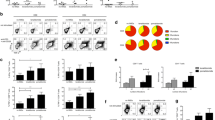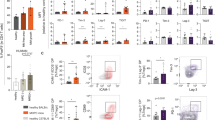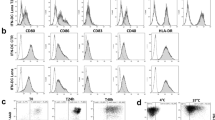Abstract
Lenalidomide is an effective therapeutic agent for multiple myeloma that exhibits immunomodulatory properties including the activation of T and NK cells. The use of lenalidomide to reverse tumor-mediated immune suppression and amplify myeloma-specific immunity is currently being explored. In the present study, we examined the effect of lenalidomide on T-cell activation and its ability to amplify responses to a dendritic cell-based myeloma vaccine. We demonstrate that exposure to lenalidomide in the context of T-cell expansion with direct ligation of CD3/CD28 complex results in polarization toward a Th1 phenotype characterized by increased IFN-γ, but not IL-10 expression. In vitro exposure to lenalidomide resulted in decreased levels of regulatory T cells and a decrease in T-cell expression of the inhibitory marker, PD-1. Lenalidomide also enhanced T-cell proliferative responses to allogeneic DCs. Most significantly, lenalidomide treatment potentiated responses to the dendritic cell/myeloma fusion vaccine, which were characterized by increased production of inflammatory cytokines and increased cytotoxic lymphocyte-mediated lysis of autologous myeloma targets. These findings indicate that lenalidomide enhances the immunologic milieu in patients with myeloma by promoting T-cell proliferation and suppressing inhibitory factors, and thereby augmenting responses to a myeloma-specific tumor vaccine.






Similar content being viewed by others
References
Pratt G, Goodyear O, Moss P (2007) Immunodeficiency and immunotherapy in multiple myeloma. Br J Haematol 138:563–579
Dong H, Strome SE, Salomao DR et al (2002) Tumor-associated B7–H1 promotes T-cell apoptosis: a potential mechanism of immune evasion. Nat Med 8:793–800
Rosenblatt J, Glotzbecker B, Mills H et al (2011) PD-1 blockade by CT-011, anti-PD-1 antibody, enhances ex vivo T-cell responses to autologous dendritic cell/myeloma fusion vaccine. J Immunother 34:409–418
Dimopoulos M, Spencer A, Attal M et al (2007) Lenalidomide plus dexamethasone for relapsed or refractory multiple myeloma. N Engl J Med 357:2123–2132
Weber DM, Chen C, Niesvizky R et al (2007) Lenalidomide plus dexamethasone for relapsed multiple myeloma in North America. N Engl J Med 357:2133–2142
Gay F, Hayman SR, Lacy MQ et al (2010) Lenalidomide plus dexamethasone versus thalidomide plus dexamethasone in newly diagnosed multiple myeloma: a comparative analysis of 411 patients. Blood 115:1343–1350
Zonder JA, Crowley J, Hussein MA et al (2010) Lenalidomide and high-dose dexamethasone compared with dexamethasone as initial therapy for multiple myeloma: a randomized Southwest oncology group trial (S0232). Blood 116:5838–5841
Attal M, Cances Lauwers V, Marit G et al (2010) Maintenance treatment with lenalidomide after transplantation for MYELOMA: final analysis of the IFM 2005–02 [abstract 310]. Blood (ASH Annual Meeting Abstracts) 116:310
McCarthy PL, Owzar K, Anderson KC et al (2010) Phase III intergroup study of lenalidomide versus placebo maintenance therapy following single autologous hematopoietic stem cell transplantation (AHSCT) for multiple myeloma: CALGB 100104 [abstract 37]. Blood (ASH Annual Meeting Abstracts) 116:37
Hideshima T, Chauhan D, Shima Y et al (2000) Thalidomide and its analogs overcome drug resistance of human multiple myeloma cells to conventional therapy. Blood 96:2943–2950
D’Amato RJ, Loughnan MS, Flynn E, Folkman J (1994) Thalidomide is an inhibitor of angiogenesis. Proc Natl Acad Sci USA 91:4082–4085
Breitkreutz I, Raab MS, Vallet S et al (2008) Lenalidomide inhibits osteoclastogenesis, survival factors and bone-remodeling markers in multiple myeloma. Leukemia 22:1925–1932
Geitz H, Handt S, Zwingenberger K (1996) Thalidomide selectively modulates the density of cell surface molecules involved in the adhesion cascade. Immunopharmacology 31:213–221
LeBlanc R, Hideshima T, Catley LP et al (2004) Immunomodulatory drug costimulates T cells via the B7-CD28 pathway. Blood 103:1787–1790
Hayashi T, Hideshima T, Akiyama M et al (2005) Molecular mechanisms whereby immunomodulatory drugs activate natural killer cells: clinical application. Br J Haematol 128:192–203
Görgün G, Calabrese E, Soydan E et al (2010) Immunomodulatory effects of lenalidomide and pomalidomide on interaction of tumor and bone marrow accessory cells in multiple myeloma. Blood 116:3227–3237
Davies FE, Raje N, Hideshima T et al (2001) Thalidomide and immunomodulatory derivatives augment natural killer cell cytotoxicity in multiple myeloma. Blood 98:210–216
Galustian C, Meyer B, Labarthe MC et al (2009) The anti-cancer agents lenalidomide and pomalidomide inhibit the proliferation and function of T regulatory cells. Cancer Immunol Immunother 58:1033–1045
Idler I, Giannopoulos K, Zenz T et al (2010) Lenalidomide treatment of chronic lymphocytic leukaemia patients reduces regulatory T cells and induces Th17 T helper cells. Br J Haematol 148:948–950
Lioznov M, El-Cheikh J Jr, Hoffmann F et al (2010) Lenalidomide as salvage therapy after allo-SCT for multiple myeloma is effective and leads to an increase of activated NK (NKp44(+)) and T (HLA-DR(+)) cells. Bone Marrow Transplant 45:349–353
Spina F, Montefusco V, Crippa C et al (2011) Lenalidomide can induce long-term responses in patients with multiple myeloma relapsing after multiple chemotherapy lines, in particular after allogeneic transplant. Leukemia Lymphoma 52:1262–1270
Tohnya TM, Hwang K, Lepper ER et al (2004) Determination of CC-5013, an analogue of thalidomide, in human plasma by liquid chromatography-mass spectrometry. J Chromatogr, B: Anal Technol Biomed Life Sci 811:135–141
Richardson PG, Blood E, Mitsiades CS et al (2006) A randomized phase 2 study of lenalidomide therapy for patients with relapsed or relapsed and refractory multiple myeloma. Blood 108:3458–3464
Blum W, Klisovic RB, Becker H et al (2010) Dose escalation of lenalidomide in relapsed or refractory acute leukemias. J Clin Oncol 28:4919–4925
Vasir B, Borges V, Wu Z et al (2005) Fusion of dendritic cells with multiple myeloma cells results in maturation and enhanced antigen presentation. Br J Haematol 129:687–700
Yin L, Li Y, Ren J, Kuwahara H, Kufe D (2003) Human MUC1 carcinoma antigen regulates intracellular oxidant levels and the apoptotic response to oxidative stress. J Biol Chem 278:35458–35464
Wei L, Laurence A, O’Shea JJ (2008) New insights into the roles of Stat5a/b and Stat3 in T cell development and differentiation. Semin Cell Dev Biol 19:394–400
Yao Z, Kanno Y, Kerenyi M et al (2007) Nonredundant roles for Stat5a/b in directly regulating Foxp3. Blood 109:4368–4375
Cohen AC, Nadeau KC, Tu W et al (2006) Cutting edge: decreased accumulation and regulatory function of CD4 + CD25(high) T cells in human STAT5b deficiency. J Immunol 177:2770–2774
Murawski MR, Litherland SA, Clare-Salzler MJ, Davoodi-Semiromi A (2006) Upregulation of foxp3 expression in mouse and human Treg is IL-2/STAT5 dependent: implications for the NOD STAT5B mutation in diabetes pathogenesis. Ann N Y Acad Sci 1079:198–204
Disis ML (2010) Immune regulation of cancer. J Clin Oncol 28:4531–4538
Neuber B, Herth I, Tolliver C et al (2011) Lenalidomide enhances antigen-specific activity and decreases CD45RA expression of T-cells from patients with multiple myeloma. J Immunol 187:1047–1056
Lee BN, Gao H, Cohen EN et al (2011) Treatment with lenalidomide modulates T-cell immunophenotype and cytokine production in patients with chronic lymphocytic leukemia. Cancer 117:3999–4008
Minnema MC, van der Veer MS, Aarts T, Emmelot M, Mutis T, Lokhorst HM (2009) Lenalidomide alone or in combination with dexamethasone is highly effective in patients with relapsed multiple myeloma following allogeneic stem cell transplantation and increases the frequency of CD4 + Foxp3 + T-cells. Leukemia 23:605–607
Kneppers E, van der Holt B, Kersten MJ et al (2011) Lenalidomide maintenance following non-myeloablative allogeneic stem cell transplantation in multiple myeloma is not feasible: results of the HOVON 76 trial. Blood 118:2413–2419
Konishi J, Yamazaki K, Azuma M, Kinoshita I, Dosaka-Akita H, Nishimura M (2004) B7–H1 expression on non-small cell lung cancer cells and its relationship with tumor-infiltrating lymphocytes and their PD-1 expression. Clin Cancer Res 10:5094–5100
Zhang L, Gajewski TF, Kline J (2009) PD-1/PD-L1 interactions inhibit antitumor immune responses in a murine acute myeloid leukemia model. Blood 114:1545–1552
Mumprecht S, Schürch C, Schwaller J, Solenthaler M, Ochsenbein AF (2009) Programmed death 1 signaling on chronic myeloid leukemia-specific T cells results in T-cell exhaustion and disease progression. Blood 114:1528–1536
Iwai Y, Ishida M, Tanaka Y, Okazaki T, Honjo T, Minato N (2002) Involvement of PD-L1 on tumor cells in the escape from host immune system and tumor immunotherapy by PD-L1 blockade. Proc Natl Acad Sci USA 99:12293–12297
Benson DM Jr, Bakan CE, Mishra A et al (2010) The PD-1/PD-L1 axis modulates the natural killer cell versus multiple myeloma effect: a therapeutic target for CT-011, a novel, monoclonal anti-PD-1 antibody. Blood 116:2286–2294
Gong J, Chen D, Kashiwaba M, Kufe D (1997) Induction of antitumor activity by immunization with fusions of dendritic and carcinoma cells. Nat Med 3:558–561
Gong J, Nikrui N, Chen D et al (2000) Fusions of human ovarian carcinoma cells with autologous or allogeneic dendritic cells induce antitumor immunity. J Immunol 165:1705–1711
Parkhurst MR, DePan C, Riley JP, Rosenberg SA, Shu S (2003) Hybrids of dendritic cells and tumor cells generated by electrofusion simultaneously present immunodominant epitopes from multiple human tumor-associated antigens in the context of MHC class I and class II molecules. J Immunol 170:5317–5325
Rosenblatt J, Vasir B, Uhl L et al (2011) Vaccination with dendritic cell/tumor fusion cells results in cellular and humoral antitumor immune responses in patients with multiple myeloma. Blood 117:393–402
Vasir B, Wu Z, Crawford K et al (2008) Fusions of dendritic cells with breast carcinoma stimulate the expansion of regulatory T cells while concomitant exposure to IL-12, CpG oligodeoxynucleotides, and anti-CD3/CD28 promotes the expansion of activated tumor reactive cells. J Immunol 181:808–821
Acknowledgments
This study was supported by research funding from Celgene to J.R.
Conflict of interest
J.R. has received research funding from Celgene. K.C.A. is on the advisory board of Celgene. The remaining authors declare no competing conflicts of interest.
Author information
Authors and Affiliations
Corresponding author
Electronic supplementary material
Below is the link to the electronic supplementary material.
Rights and permissions
About this article
Cite this article
Luptakova, K., Rosenblatt, J., Glotzbecker, B. et al. Lenalidomide enhances anti-myeloma cellular immunity. Cancer Immunol Immunother 62, 39–49 (2013). https://doi.org/10.1007/s00262-012-1308-3
Received:
Accepted:
Published:
Issue Date:
DOI: https://doi.org/10.1007/s00262-012-1308-3




